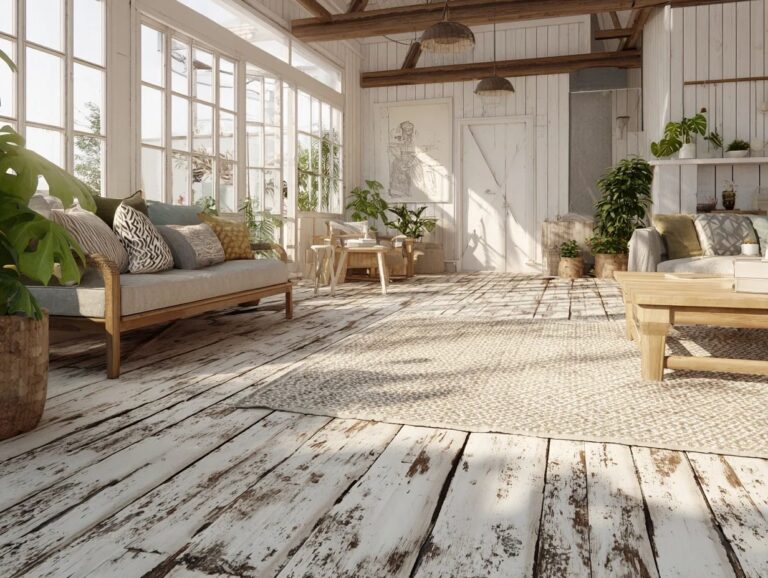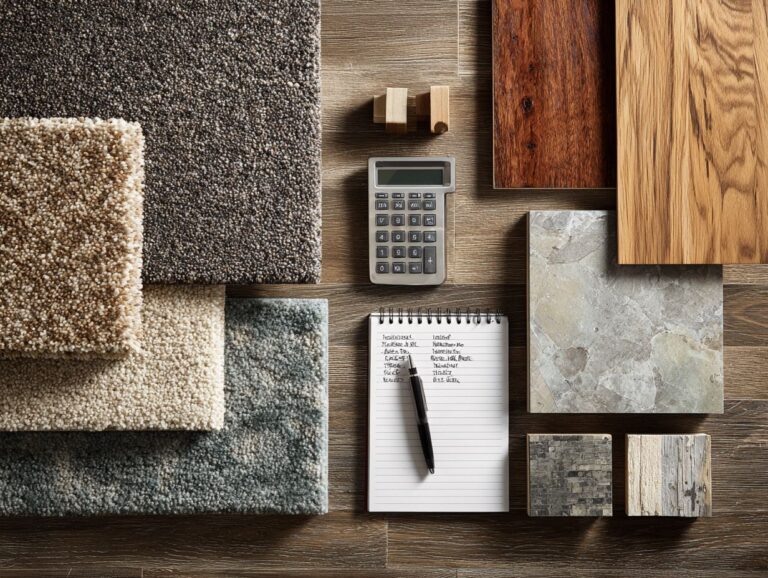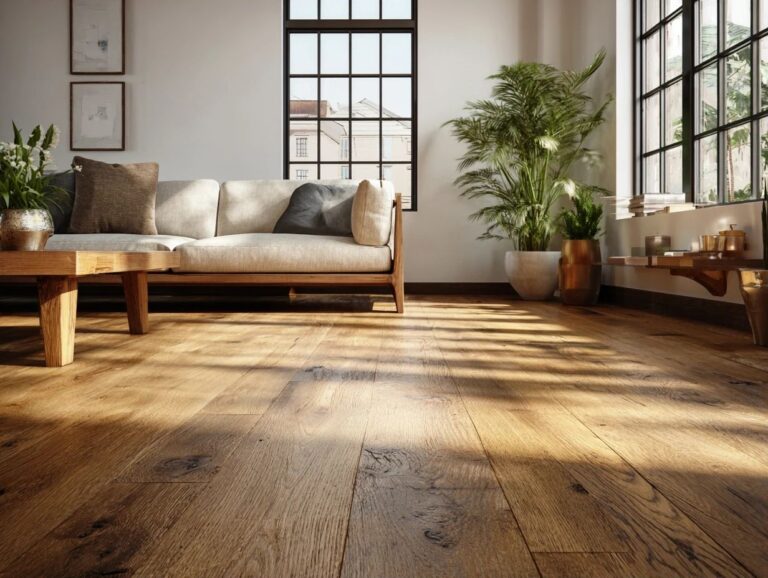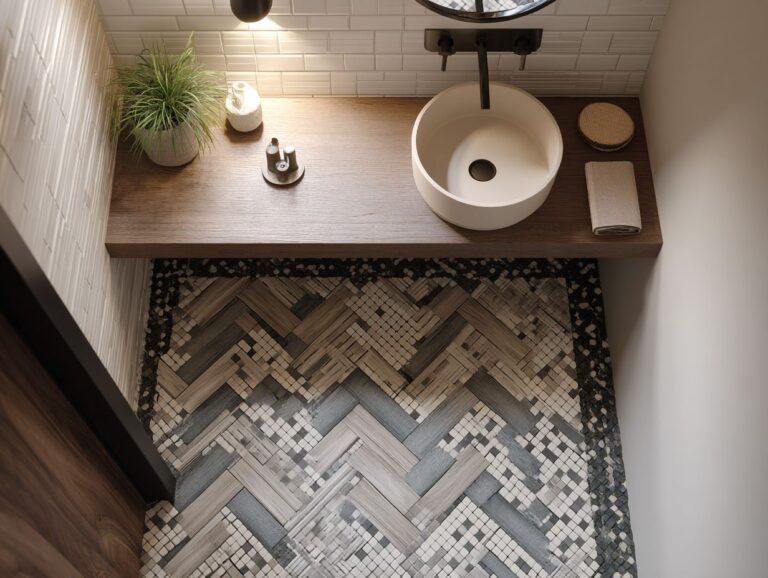Sunroom Flooring Options – UV and Temperature Resistant
Do you want to change the flooring in your sunroom to make it just right? Sunroom flooring options like luxury vinyl, ceramic tile, and hardwood flooring offer a blend of beauty and durability, ideal for withstanding UV rays and temperature changes. Learn how luxury vinyl plank and porcelain tile can improve your space and offer strong resistance against environmental factors. This guide will help you choose the right materials for a stunning and functional sunroom that lasts for years.
Key Takeaways:
Contents
- Types of Flooring Materials
- UV Resistance of Flooring Options
- Temperature Resistance of Flooring Options
- Maintenance and Care
- Cost Considerations
- Sunroom Flooring Durability Statistics
- Installation Options
- Frequently Asked Questions
- What are the best flooring options for a sunroom that is exposed to UV and extreme temperatures?
- Is hardwood flooring a suitable option for a sunroom that receives a lot of sunlight and heat?
- Can carpet be used in a sunroom that receives a lot of sunlight and heat?
- What is the most cost-effective flooring option for a sunroom that is exposed to UV and temperature changes?
- Can laminate flooring withstand the extreme temperatures in a sunroom?
- Are there any maintenance tips for keeping sunroom flooring in good condition?
Importance of Choosing the Right Flooring
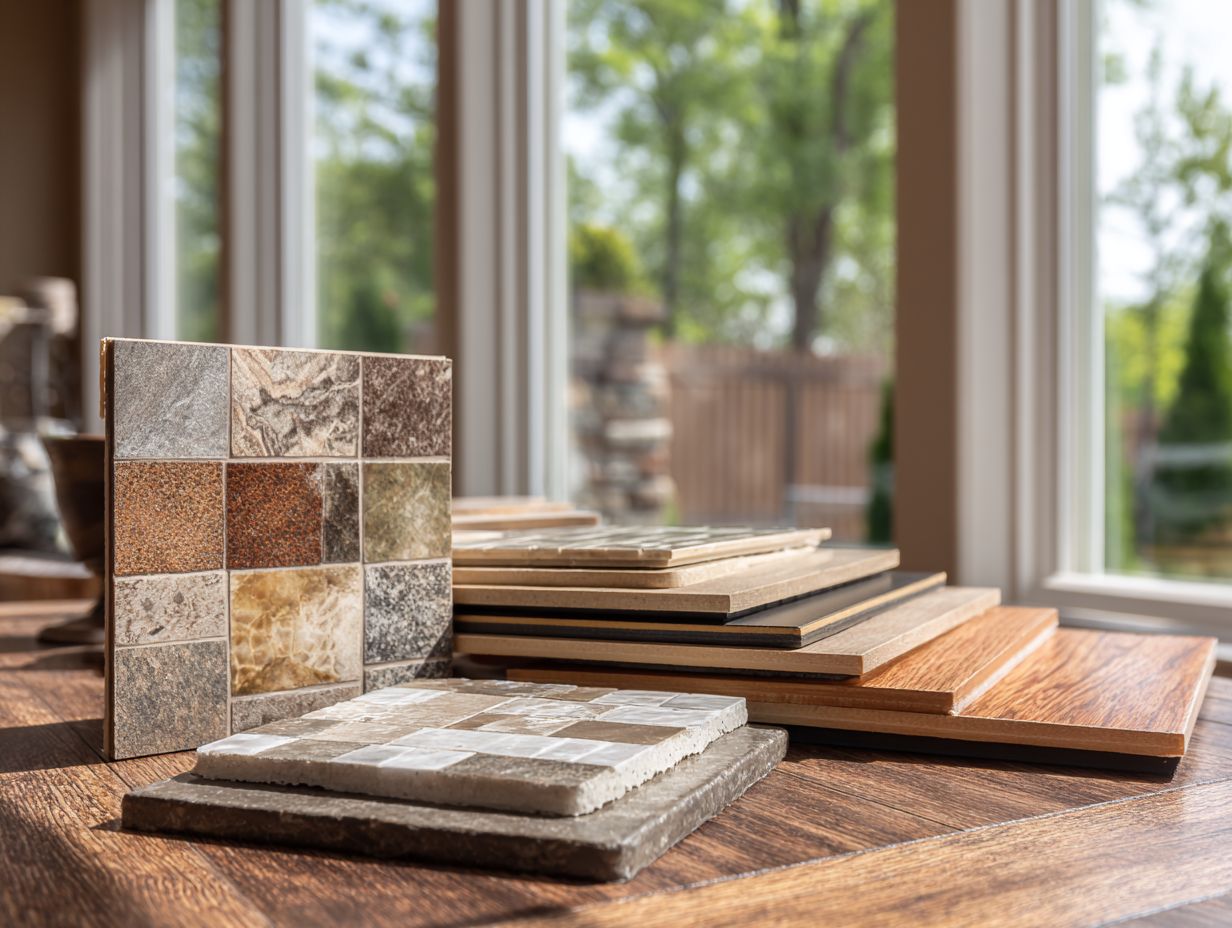
Picking the right flooring can greatly improve both the comfort and look of your sunroom, turning it into a pleasant place to relax.
Consider using ceramic tile because it is easy to clean and doesn’t absorb water, making it ideal for sunrooms.
Laminate flooring offers a cost-effective option with a variety of designs that mimic hardwood and is also easy to install.
For a touch of luxury, natural stone provides durability and a unique appearance but at a higher cost and installation complexity.
According to recent surveys, over 70% of homeowners prioritize aesthetic appeal when selecting flooring, underscoring the importance of choosing a material that reflects your personal style while also ensuring comfort.
Factors to Consider
When selecting flooring for your sunroom, consider factors like moisture resistance, economic efficiency, and comfort underfoot.
Moisture resistance is very important, especially if your sunroom often has high humidity or gets direct rain. For example, vinyl flooring is more durable than carpet, which makes it perfect for these areas.
Comfort is also a key consideration; hardwood provides warmth and a luxurious feel, while laminate can mimic wood at a lower cost.
Look for UV protection, as some materials fade less than others in direct sunlight, enhancing longevity. Speaking with flooring experts can give you custom advice, helping you choose materials that fit your style and needs.
Types of Flooring Materials
There are many types of flooring you can choose for sunrooms, such as luxury vinyl, tile, laminate, and natural stone.
Each offers different features.
Vinyl Flooring
Luxury Vinyl Plank (LVP) is a popular choice for sunrooms due to its waterproof options and wood-like appearance.
Apart from its look, LVP is very durable, resisting scratches and dents. This makes it perfect for places with a lot of foot traffic.
Pricing typically ranges from $2 to $5 per square foot, providing a budget-friendly flooring solution.
Unlike traditional vinyl, LVP features a thicker wear layer, enhancing comfort underfoot. Users often appreciate the wide variety of styles, allowing them to mimic various hardwood species.
For easy installation, many opt for click-lock LVP, which can be installed as a DIY project, saving on labor costs and timelines.
Tile Flooring
Tile flooring, particularly porcelain and ceramic, offers durability and a variety of styles that can fit any sunroom design.
Tiles cost between $3 and $10 per square foot. They are cost-effective and can withstand dampness, making them perfect for sunrooms with a lot of humidity.
Popular design trends feature big tiles that make a room look larger and natural stone styles that create a calm environment. For example, a sunroom with light grey ceramic tiles can offer a peaceful escape, while colorful patterned tiles can add character.
Cleaning is easy; a basic mop and gentle soap typically suffice to keep them clean, offering a great mix of attractiveness and usefulness.
Laminate Flooring
Laminate flooring is a cost-effective choice that looks like wood, appealing to homeowners who want to save money.
With costs typically ranging from $1 to $4 per square foot, laminate is significantly cheaper than hardwood, which averages $5 to $10 per square foot.
Putting it in place is simple and usually needs only a saw and a tapping block, so it’s perfect for those who like to tackle projects themselves.
Laminate can be less durable in high-moisture areas, so consider using it in living rooms or bedrooms, while opting for waterproof alternatives in kitchens or bathrooms.
This option lets homeowners get fashionable flooring without spending too much money.
Natural Stone Flooring
Natural stone flooring, such as slate and limestone, provides a unique aesthetic and unmatched durability for sunrooms.
These materials improve the look of your space and control temperature, keeping floors warm in winter and cool in summer. Natural stone costs between $5 and $15 per square foot, offering good value for money.
Maintenance is essential; regular sealing can prevent stains and moisture damage. Be aware that seasonal changes can affect stone; for example, freeze-thaw cycles may cause cracking if not properly maintained.
Using durable stone and regular maintenance keeps your sunroom looking good for a long time.
Carpet Options
Carpet can make sunrooms feel cozy and comfortable, which is great for colder areas.
When considering carpet for your sunroom, evaluate types like indoor-outdoor carpet, which is durable and moisture-resistant, costing about $2-$4 per square foot.
Alternatively, choose wool carpet, renowned for its comfort and natural resistance to mold, priced around $5-$6 per square foot.
Installing correctly is important; a good fit minimizes seams and improves how it looks. Also, consider using low-VOC adhesives to improve indoor air quality.
This thorough method improves comfort and creates a better environment in the sunroom.
UV Resistance of Flooring Options
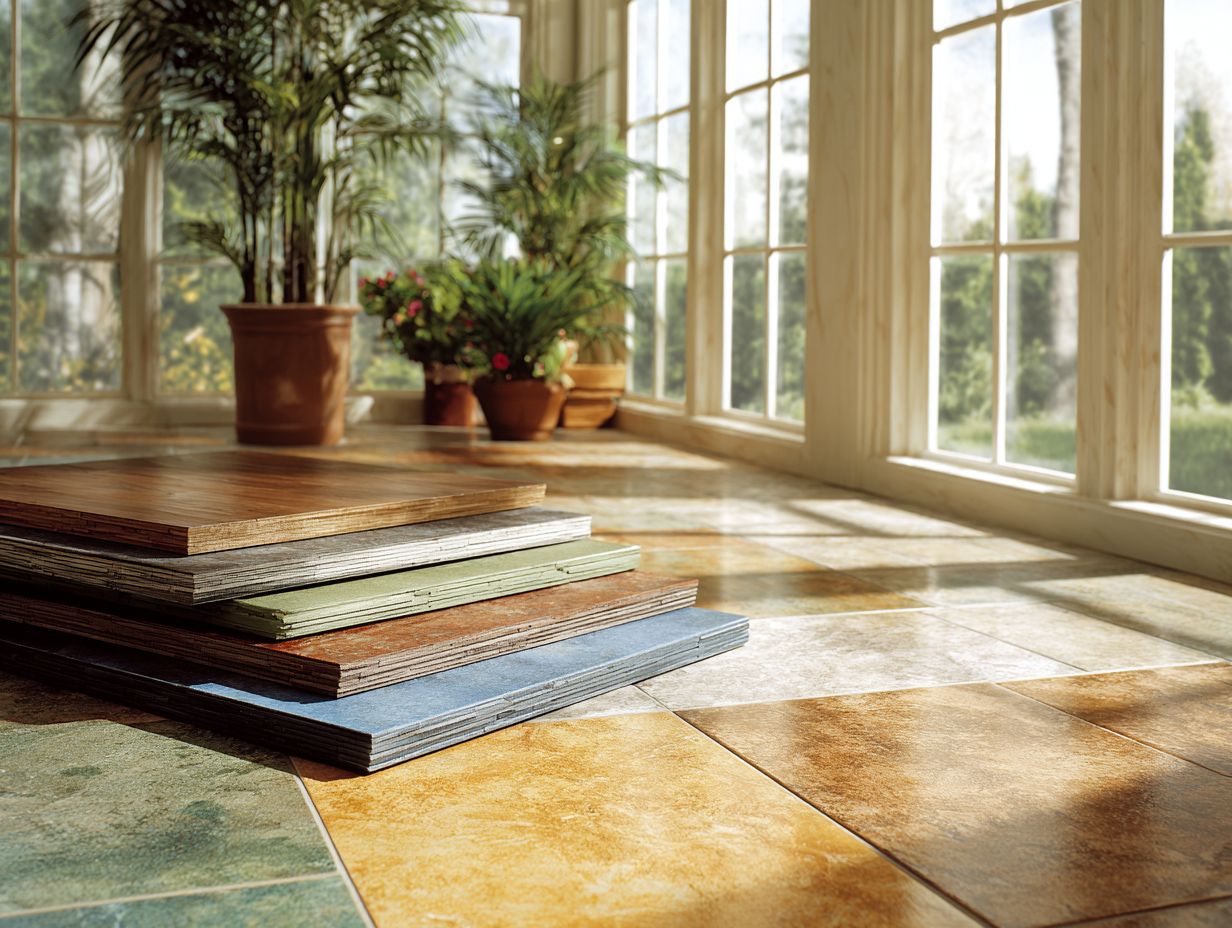
It’s important to think about UV resistance when picking flooring for sunrooms to avoid fading and harm as time goes on. For a deeper understanding of how flooring materials like vinyl can provide UV resistance, consider the differences between linoleum and vinyl flooring options, which may offer varying levels of protection.
Understanding UV Damage
UV rays can cause significant damage to flooring, leading to color fading and structural weakening of materials.
Hardwood floors are particularly susceptible to UV exposure, which can cause warping and significant fading over time. Oak hardwood can change color with extended exposure, which means it must be refinished every few years.
In contrast, vinyl flooring, while resistant to warping, can still experience fading, especially in brightly lit areas.
To minimize damage, consider using UV-filtering window films or installing shades and curtains.
Regularly rotating area rugs and rearranging furniture can further protect your flooring from uneven sun damage, preserving its appearance and lifespan.
Best UV Resistant Materials
Porcelain tile and high-quality laminate are among the best options for withstanding UV damage in sunrooms.
Vinyl plank flooring is also an excellent choice, offering UV resistance and water durability. Pricing varies, but expect to pay around $2-$7 per square foot, with installation typically costing an additional $2-$5 per square foot.
Porcelain tiles are more expensive, ranging from $4-$10 per square foot but provide superior longevity. High-quality laminate, while less expensive at $1-$5 per square foot, requires careful maintenance to avoid sun fading.
Proper care can extend the life of these choices from 10 to 25 years, making them suitable for places with exposure to UV light.
Temperature Resistance of Flooring Options
Picking flooring that can withstand temperature changes is important for lasting durability and performance in climates that vary.
Impact of Temperature Fluctuations
Temperature fluctuations can lead to expansion and contraction in flooring materials, potentially causing damage over time.
Vinyl flooring is very flexible, which makes it a good choice for places where the temperature changes. Hardwood is prone to warping and gaps as it expands and contracts.
To minimize damage, apply a humidifier in dry seasons to maintain consistent moisture levels, and use area rugs to protect hardwood from direct sunlight.
Regularly check for damage, especially in materials affected by temperature, and think about routine treatment for hardwood to increase its strength against weather changes.
Choosing Temperature Resistant Materials
Choosing materials such as engineered hardwood or high-quality vinyl can improve how well sunrooms handle temperature changes.
Consider incorporating insulation features alongside these flooring choices. For instance, adding radiant barriers can prevent heat loss during colder months, while thermal curtains help regulate temperature.
When selecting engineered hardwood, look for options with a high density rating to improve durability. Conversely, luxury vinyl planks usually have a waterproof core, which makes them great for damp places.
By combining these materials with proper insulation techniques, you can create a comfortable atmosphere that stands the test of time.
Maintenance and Care
Regular upkeep and care are necessary to extend the lifespan and look of sunroom flooring.
Cleaning UV Resistant Flooring
UV resistant flooring requires specific cleaning methods to maintain its durability and appearance.
To keep your luxury vinyl and porcelain tile looking pristine, use a microfiber mop and a pH-neutral cleaner, such as Bona Hard Surface Cleaner or Armstrong Once ‘n Done.
Clean spills immediately to prevent stains, and sweep or vacuum regularly to remove dirt and grit. Ideally, wash your flooring once a week for high-traffic areas, while less frequented spaces can be cleaned bi-weekly.
Always avoid abrasive tools and harsh chemicals, as these can damage the finish over time.
Maintaining Temperature Resistant Flooring
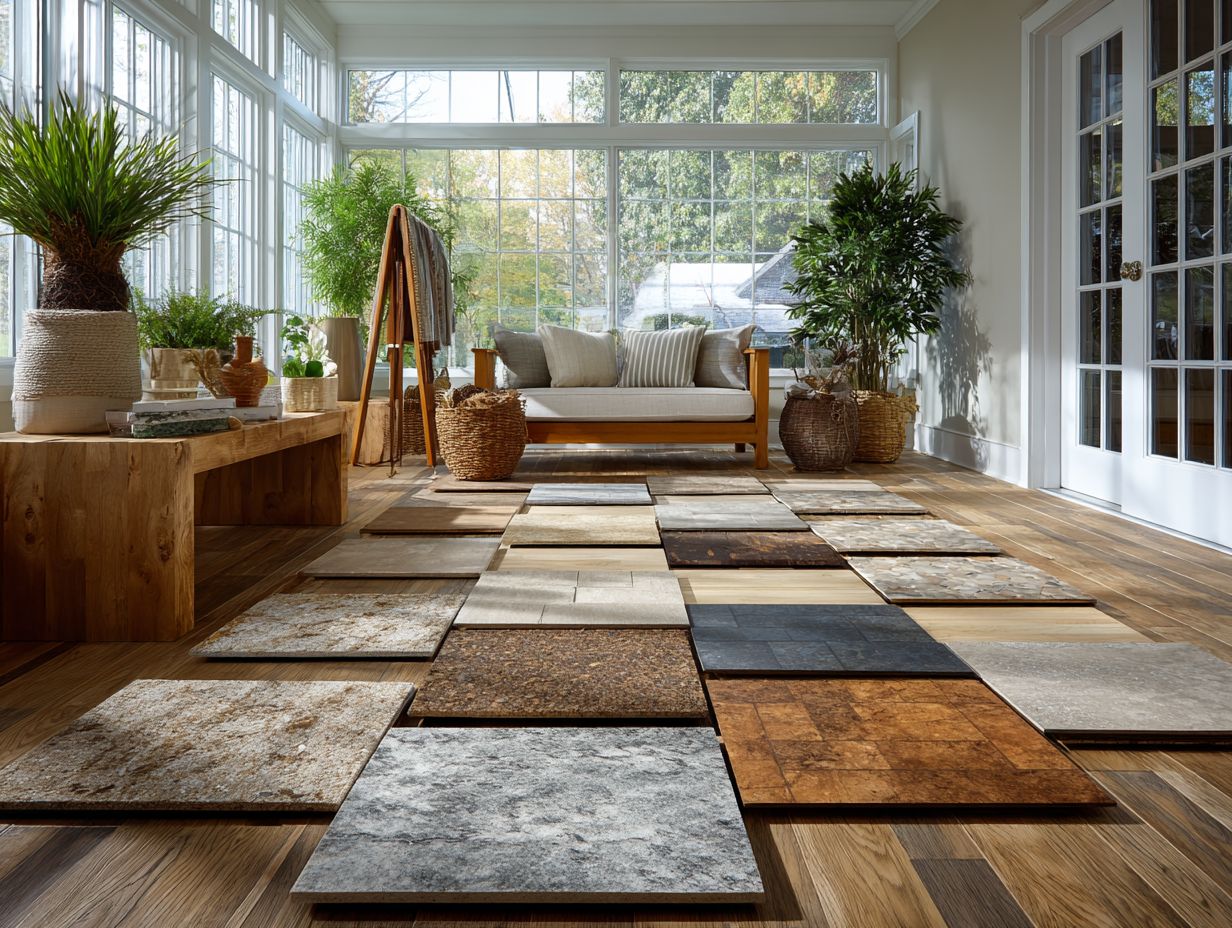
Flooring materials that can withstand temperature changes, such as engineered hardwood and laminate, need specific care to last a long time.
- Start by cleaning regularly with a laminate floor cleaner and a microfiber cloth to remove dirt and prevent scratches.
- To prevent too much moisture, clean up spills right away and use a damp mop instead of a wet one.
- It’s important to look after your belongings according to the time of year. In winter, use methods to control humidity to maintain proper levels and stop cracking.
- Place mats at entryways to minimize dirt and debris from being tracked in, further protecting your floors from wear and tear.
Cost Considerations
Knowing the prices of various flooring materials is important for planning your budget in sunroom remodels.
Budgeting for Sunroom Flooring
Creating a budget for sunroom flooring involves evaluating material costs, installation fees, and potential upkeep expenses.
Start by researching the costs of various flooring materials. For instance, vinyl typically ranges from $4 to $8 per square foot, while hardwood can be $8 to $15.
Next, add installation costs, which can vary widely-expect an extra $2 to $5 per square foot for professional installation.
Factor in long-term maintenance; for example, laminate flooring requires minimal upkeep compared to carpet, which may need regular cleaning and replacement.
A simple budget template can help track these expenses clearly and effectively.
Long-term Value of Flooring Choices
Investing in higher-quality flooring can yield long-term value through durability and reduced maintenance costs.
Hardwood flooring costs between $8-$15 per square foot upfront. With regular care, it can last more than 50 years, making it a cost-effective choice over time.
In contrast, laminate flooring, costing $2-$5 per square foot, typically lasts about 10-20 years.
Many homeowners find that putting tile in busy areas makes floors more durable and often increases home values by 5-10%.
When selecting, consider your lifestyle and expected usage to maximize your investment’s value.
Sunroom Flooring Durability Statistics
Sunroom Flooring Durability Statistics
Durability and Performance: Resistance and Durability
Durability and Performance: Cost and Maintenance
The Sunroom Flooring Durability Statistics give detailed information about how long different flooring options last, how well they work, and how much they cost. This information is important for homeowners and designers looking for the best flooring options for sunrooms, where there is a lot of sunlight and moisture.
Durability and Performance metrics highlight different flooring materials’ resistance to moisture and fading.
- LVP (Luxury Vinyl Plank) exhibits a 95% moisture resistance and 94% fading resistance making it a strong option for protecting against water damage and sun exposure. These properties help LVP keep its look and work well for a long time.
- Tile flooring outperforms with 98% moisture resistance and 99% fading resistance. Its superior performance makes it ideal for sunrooms where high humidity and sunlight exposure are prevalent, providing longevity and maintaining aesthetic appeal.
- Engineered Hardwood, while offering a respectable 85% durability, may require more attention in sunrooms due to its lower resistance to moisture compared to LVP and tile.
Cost and Maintenance factors are also critical.
- LVP flooring is a cost-effective alternative, with its cost being only 70% compared to traditional hardwood. This affordability, coupled with its durability, makes LVP a practical choice for budget-conscious consumers.
- Tile flooring has an estimated cost of $15 per unit, offering a balance between performance and expense.
- Engineered Hardwood entails a maintenance cost of $20, reflecting potentially higher upkeep compared to the other materials, due to its susceptibility to moisture-related issues.
In conclusion, the Sunroom Flooring Durability Statistics suggest that tile offers the highest resistance and longevity under sunroom conditions, albeit at a moderate cost. LVP provides a durable and cost-effective alternative, while engineered hardwood, though aesthetically pleasing, may demand more maintenance and care in moisture-prone environments. Choosing the right flooring means considering these elements to fit particular needs and tastes, making sure it lasts and looks good in sunrooms.
Installation Options
Deciding how to install your sunroom flooring can impact both the price and the final result of your project. For example, choosing between materials like linoleum and vinyl can significantly affect cost and durability. Our guide on understanding the differences between linoleum and vinyl provides valuable insights that can help you make an informed decision.
DIY vs. Professional Installation
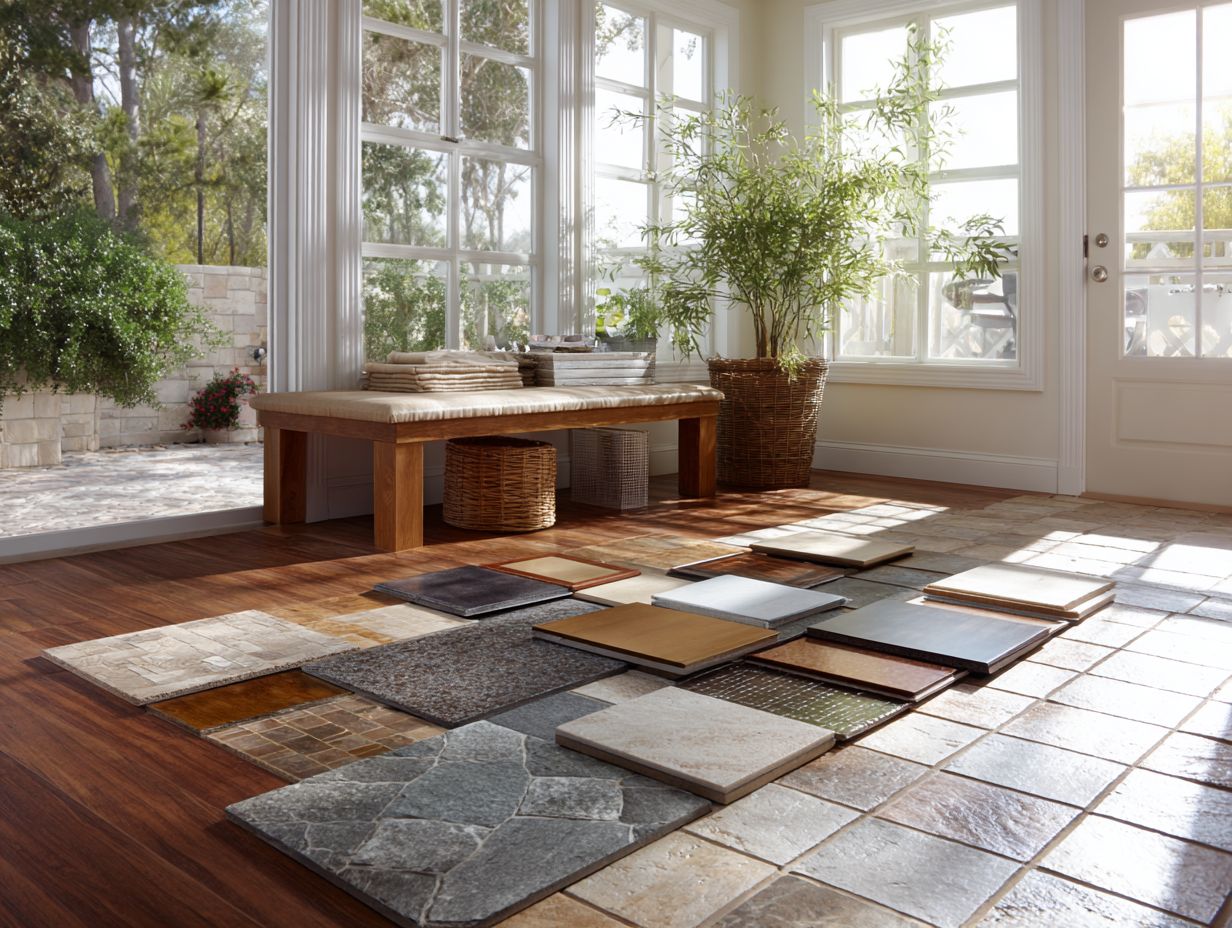
Deciding between DIY and professional installation for sunroom flooring depends on your skill level, budget, and desired outcome.
For DIY enthusiasts, vinyl plank flooring is often ideal due to its affordability and ease of installation, typically costing between $2 to $7 per square foot.
On the other hand, hiring professionals can range from $2,000 to $5,000 based on material choice and labor complexity.
error 400- bad request
Many people finish projects in a weekend, while professionals can deliver a perfect result with guarantees and experience.
Preparing the Sunroom for Flooring
Getting your sunroom ready can make your flooring installation work better.
Start by clearing the area of furniture and debris, creating an open workspace.
Next, check for moisture issues by inspecting walls and the subfloor, as moisture can compromise flooring longevity.
If any dampness is detected, address it immediately, possibly by applying a vapor barrier. Ensure the subfloor is clean and level.
Sweep thoroughly and use a leveling compound if necessary to fill any low spots.
Following these steps will create a solid foundation for a successful flooring installation.
Frequently Asked Questions
What are the best flooring options for a sunroom that is exposed to UV and extreme temperatures?
The best flooring options for a sunroom that is exposed to UV and temperature changes are vinyl, porcelain, and ceramic tiles. These materials are durable and resistant to fading, warping, and cracking.
Is hardwood flooring a suitable option for a sunroom that receives a lot of sunlight and heat?
No, hardwood flooring is not recommended for a sunroom that is exposed to UV and temperature changes. Continuous sunlight can make the wood lose its color and change shape, which makes it unsuitable for this environment.
Can carpet be used in a sunroom that receives a lot of sunlight and heat?
No, carpet is not a suitable option for a sunroom that is exposed to UV and temperature changes. It can lose its color and darken over time, and the high moisture and warmth can lead to mold and mildew growth, making it a bad option for this area.
What is the most cost-effective flooring option for a sunroom that is exposed to UV and temperature changes?
Vinyl flooring is the most cost-effective option for a sunroom that is exposed to UV and temperature changes. It is durable, easy to install, and has a wide range of design options to choose from.
Can laminate flooring withstand the extreme temperatures in a sunroom?
Yes, laminate flooring is a good option for a sunroom that is exposed to UV and temperature changes. It is resistant to fading and warping and can mimic the look of hardwood or stone at a fraction of the cost.
Are there any maintenance tips for keeping sunroom flooring in good condition?
To keep your sunroom flooring in good condition, it is important to regularly sweep and mop the floors to remove any dirt or debris. It is also recommended to use rugs or mats in high traffic areas to prevent wear and tear, and to keep the floors dry to prevent mold and mildew growth.
